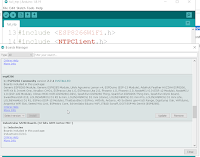A reader of my blogs announce my this issue about wrong conversion of the date/year when extract data from Unix Time (Epoch Time). Also, the solution for this issue is simple, like here: https://github.com/arduino-libraries/NTPClient/issues/149.
I open the Serial Monitor and epochTime is ok, but conversion to date notenglish version of niq_ro's articles from:
www.arduinotehniq.com (www.tehnic.go.ro) & nicuflorica.blogspot.ro + youtube channel
Total Pageviews
Sunday, March 27, 2022
How to solve the issue with incorrect date/year extract from Unix time (with ESP8266 board)
Arduino automatic model train (2)
I updated the schematic and sketch (software/program) for automatic model train.
Schematic is
and program wrote by me is controlled_model_train_3a.ino (base sketch was presented in previous article + adjust part from Doz's article Arduino Astronomical Clock (or Arduino Pond Pump Controller!)).Using menu, we can change:
- language (english/romanian language), but each can put local language instead romanian, my native language.
- succession of read the sensors, to activate sensor in movement direction
- maximum speed (PWM: 200..255)
- minimum speed (PWM: 25..150), usual 105 i minimum for real motor, 25 is best for leds
- step for speed (PWM: 2..20)
After system is powered, after welcome messages, you will see STOP! and red led flashing
until is push button from encoder:
- short push: enter in normal mode, in pause
- long push, until a star appear, enter in adjusting menu:
Steps in menu mode (adjust by encoder rotation+ enter value by pushing value, menu jump to next level):Saturday, March 26, 2022
"DCC ready" board for classical locomotive (DC loco)
original article (romanian language)
I'm new in model railway system: locomotive, railways, control, etc.
Old locomotives works with DC power, 0..12V for forward and 0..-12V for backward, so classical schematic is
so a "DCC ready" locomotive is a simple DC locomotive with "DCC ready" board, as in schematic:Sunday, March 6, 2022
Automatic white/red light for analog locomotive (DC)
Most of the simple analog locomotive use DC voltage with normal or reverse polarity, normal polarity go locomotive forward and reverse voltage go locomotive backward.
I used for test on breadboard a 5mm bicolour led (red/white) LTW30EEDYJA but for 3mm can be used OSRWPA3132A.
I designed a simple schematic with additional 3 pieces: 2 diodes (1N4007) and a resistor (680Ω..1kΩ):

























































